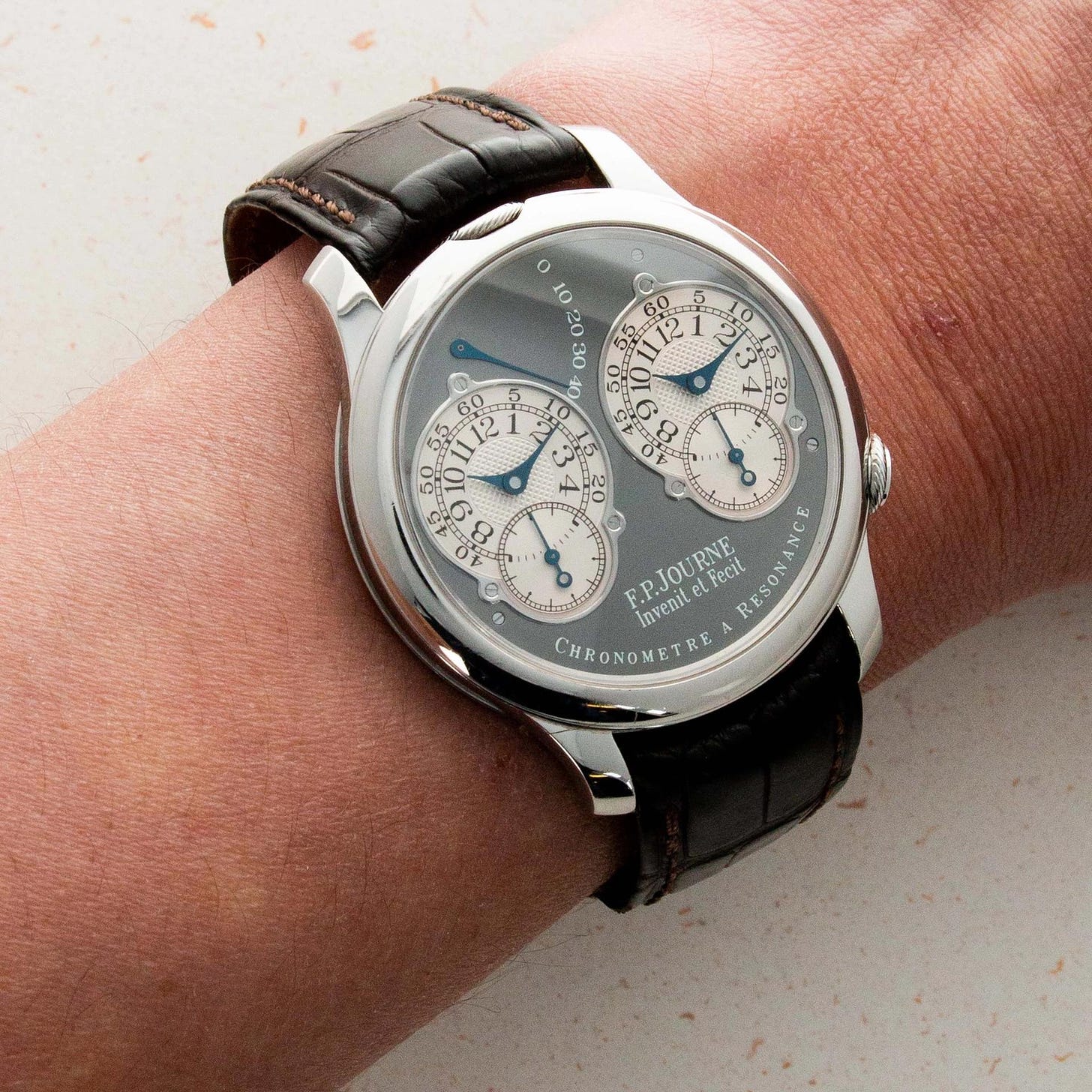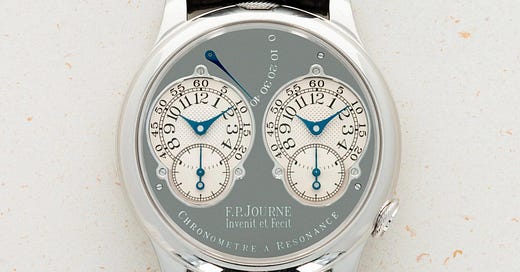For more analysis and coverage of watch trends, subscribe to get Rescapement delivered to your inbox every Sunday:

When the pandemic hit, many traditional auction houses worked to quickly shift sales online, even moving away from big in-person sales to host weekly online auctions.
It worked, too. While overall watch auction sales were down in 2020, online sales nearly quadrupled, from $18m to $65m, according to The Mercury Project. In addition to more sales, these auction houses — and their bidders — also got used to bigger, crazier watches being sold online. In November 2020, Phillips posted a world-record online auction sale, selling a Patek Philippe World Timer reference 2523 for $5.5m, with the winning bid coming from online. While not an auction, online retailer A Collected Man recently sold a Philippe Dufour Grande et Petite Sonnerie for north of $7m.
Sotheby’s head of watches told Revolution that its average price of watches sold online went up 50 percent in 2020 as compared to 2019. Online sales also attracted a new generation of bidders. Sotheby’s reported that 25 percent of bidders in its online sales were first-timer bidders; meanwhile, Christie’s has reported that 32 percent of new online-only sale buyers were millennials.
Watches, in other words, were finally catching up with the (online) times.
In addition to traditional auction houses, a new crop of online-native platforms popped up to sell watches online. Leading the pack is Loupe This, led by founders Eric Ku and Justin Gruenberg. Both Ku and Gruenberg are respected veterans of the watch industry, Ku as a dealer, Gruenberg as a retailer and founder of The Keystone.
The economics of Loupe This are simple: $500 to list (this covers shipping and photography of the watch), plus a 10% buyer’s premium. Traditional auction houses charge a 25% premium.
I’ve enjoyed tracking Loupe This’s sales so far. They often sell watches with no reserve, and maintain an archive of sold lots on their website, giving a real, transparent look at where the market is for certain watches. For example, an F.P. Journe Chronometre Bleu recently hammered for $65k on Loupe This; take a look at Chrono24 and you’ll be hard-pressed to find an example under $100k.
Of course, Loupe This has achieved dozens of strong results. In a nice introductory post over on Time and Tide, founder Eric Ku points to a couple vintage Rolex examples in pristine condition that hammered for strong numbers.
“Our model is all about efficiency. With a greatly reduced premium versus traditional auction houses, sellers and buyers both benefit,” Loupe This told me. As proof that buyers are benefitting too, in that Time and Tide post Ku pointed to a 1950s gold Cartier Tank Basculante that sold for $20k on Loupe This (“a lot of value,” Ku said), comparing it to an example of the same watch that sold for more than $50k through Monaco Legends recently, a result that Ku candidly referred to as “bulls**t”.
Vintage Cartier is especially hot right now, and, with Loupe This’s founders having something of a specialty in the brand, the platform has brought some much-needed transparency to that market, helping to make sense of all the madness.1

Well, this week Loupe This caught my eye because they sold their biggest watch yet: a platinum F.P. Journe Resonance with an early ruthenium dial.
This particular example is from a limited edition of 99 pieces produced in the early 2000s, with a ruthenium dial and ruthenium coated brass movement.
The early Journe Resonance ended up hammering for $352k, or a total sale price of $387,200 after Loupe This’s 10 percent buyer’s premium.
Of course, the Resonance is perhaps the most recognizable of Journe’s achievements, featuring a movement with two balance wheels assembled so closely together that they synchronize due to their frequencies aligning. These early Journe timepieces were pivotal to financing the brand’s future success.
Christie’s sold an example with box and papers for CHF 212.5k in July 2020. (Step in the way-back machine with me and take a look at this example that sold for $68k back in 2010). Loupe This’s example was sold without box and papers, but that didn’t hold it back from achieving a stronger result than that from Christie’s.

So back to the question posed in the title of this article: What does it mean? Take a look at Loupe This’s Resonance listing and you’ll notice a few things: a lot of high-quality images that don’t feel touched up; detailed descriptions; even a comment or two. All ideas that might feel totally foreign to a traditional auction house but just make sense online. In fact, take a look at that listing, compared to, say, the listing from Christie’s example from last year (19 images versus 3), and you might start to think that Loupe This didn’t achieve such a strong result in spite of being an online seller, but because it is an online seller.
“Our platform gives detailed information and a multitude of high-quality images, allowing buyers to bid confidently, even on high ticket items like this F.P. Journe Resonance,” Loupe This told me as the auction was closing.
The reality is that selling six-figure timepieces requires a ton of trust too, no matter if it’s in person or online. Trust that traditional auction houses have built into their name over hundreds of years. But it’s something that dealers like Ku and Gruenberg have earned too. It’s also something that can’t be faked. eBay has made a big push into watches with their “Authenticity Guarantee” on all watches sold on its site over $2,000, but legitimate questions about the actual authentication process have left buying on the Bay feeling like pretty much the same Wild West as before it launched this “Guarantee.”
I’ve always felt more confident dealing with individual dealers who put their own name behind a watch or product. With Loupe This, the founders have managed to lend the trust their names engender in the market to an entire platform (“buy the seller,” as the old adage goes).
As one of those “Millenials” and “first-time auction bidders” mentioned earlier (I bought my first watch via auction — online, of course — last year), online platforms like Loupe This just feel natural. Buying a watch online via a traditional auction house still felt a bit antiquated — some of the processes at some houses are retrofitted to accommodate online buyers — but this isn’t the case with sites like Loupe This. It’s dangerously easy: input credit or banking info and that’s about it. Buying a $400k F.P. Journe has about as much friction as buying toilet paper on Amazon.
Auction houses aren’t the only platform Loupe This is competing against: six-figure watches trade hands on the daily via Instagram DMs and WhatsApp messages. But those trades happen largely in private. The transparency of Loupe This sets it apart as a resource for collectors or the generally curious.
As mentioned, Loupe This isn’t the only online auction platform that’s cropped up over the past year. But, it’s the only one that’s seen any significant success. Others seem to be struggling with locking down quality inventory or selling through inventory they do find. Often, they don’t take on the significant investment of actually handling and photographing the watches they are selling the way Loupe This does (“pictures are part of the description!” I can hear some far away eBay listing yelling at me right now).
Online platforms like Loupe This are helping to bring watch collecting to a new generation of collectors. Like the internet itself, these platforms are built on transparency and the sharing of information.2
Platforms that are using the internet to find a new way of doing things are immensely more exciting than platforms that use the internet to extend the same old way of doing things. An F.P. Journe selling for $400k on one of them is just one sign of what’s to come.
Rescapement is an independent weekly newsletter about watches, mostly vintage. Subscribe now to get it delivered to your inbox every Sunday:
This gold Santos-Dumont Ultra-Thin is another example. Examples are commonly listed at 2x the $7k hammer price that Loupe This’s example saw. Other times, Loupe This helps to validate results: this platinum Santos-Dumont sold for $18.5k on Loupe This, backing up a similar result from Phillips in June. Either way, more data points are better for collectors to make informed purchases, and Loupe This provides that.
“Information wants to be free,” as techno-activists love to say.





I agree that the base cataloguing on Loupe is much better than what one gets for an online auction at the “Big Three”. Phillips deserves credit, however, for significantly enhanced cataloguing as compared to its competitors for its live sales (or, at least, longer)
A Collected Man has also distinguished itself with detailed specifications, and extensive cataloguing - it’s worth comparing their early listings to how they approach listings now. They deserve credit for investing in the research and time needed for these long-form listings, which approach journalism in many cases. Notes are obviously selling points, but nevertheless contain important data and context when done well, and so I think improve buyer confidence
I remain surprised at how little photography is available at the conventional houses for their listings - additional photos require a request, and the response one gets are photos via an iPhone, hopefully in-focus (the conventional houses, however, have their own advantages over the newer online platforms, as discussed at length everywhere)
These are all good trends, as the competition should create overall improvement in the buyer experience
Great article! Thanks as always for spotting a really interesting topic and bringing us the story
I miss the good old days of the discussion foruns and the camaraderie between participants, even when selling watches, as expensive as it can be. The world of watches has been transformed in a stupid place, with watches treated as simple commodities as costing more than a liver...